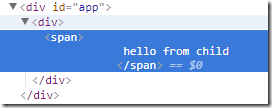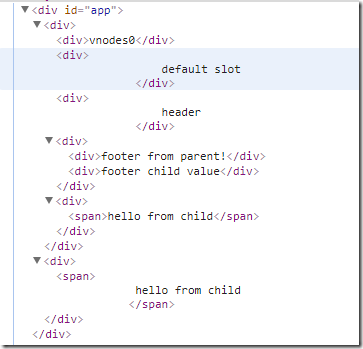Vue 测试版本:Vue.js v2.5.13
先看个插槽的例子:
<div id="app"> <child > <span slot-scope="props"> {{props.text}} </span> </child> </div>
window.onload = function() { Vue.component('child', { template: ` <div> <slot text="hello from child"></slot> </div> `, }); new Vue({ el: '#app' }); };
最终效果:
应该比较好理解,如果换成渲染函数,js 就是这样:
window.onload = function() { Vue.component('child', { render(createElement){ let vnodes1 = this.$scopedSlots.default({ text: 'hello from child' }); return createElement('div',[vnodes1]); } }); new Vue({ el: '#app' }); };
前后比较对照下,结合文档,应该能看懂;
但是插槽有很多种形式,具名与否,作用域与否等等,综合在一起,做了个 demo,代码如下:
<div id="app"> <myele> <div> default slot </div> <div slot="header"> header </div> <div slot-scope="props" slot="footer"> <div>footer from parent!</div> <div>{{props.text}}</div> </div> </myele> <child> <span slot-scope="props"> {{props.text}} </span> </child> </div>
如果依旧用 template ,js 就是这样:
window.onload = function() { Vue.component('myele', { template: ` <div> <div>vnodes0</div> <slot></slot> <slot name="header"></slot> <slot name="footer" text="footer child value"></slot> <child> <span slot-scope="props">{{props.text}}</span> </child> </div> ` }); Vue.component('child', { render(createElement) { let vnodes1 = this.$scopedSlots.default({ text: 'hello from child' }); return createElement('div', [vnodes1]); } }); new Vue({ el: '#app' }); };
效果图:
如果用渲染函数实现,就是这样:
window.onload = function() { Vue.component('myele', { render(createElement) { let vnodes0 = createElement('div', 'vnodes0'), vnodes1 = this.$slots.default, vnodes2 = this.$slots.header, vnodes3 = this.$scopedSlots.footer({ text: 'footer child value' }), vnodes4 = createElement('child', { scopedSlots: { default: function(props) { return createElement('span', props.text); } } }); return createElement('div', [vnodes0, vnodes1, vnodes2, vnodes3, vnodes4]); } }); Vue.component('child', { render(createElement) { let vnodes1 = this.$scopedSlots.default({ text: 'hello from child' }); return createElement('div', [vnodes1]); } }); new Vue({ el: '#app' }); };
两边一对照,结合文档,应该就比较清楚了
参考文档:

